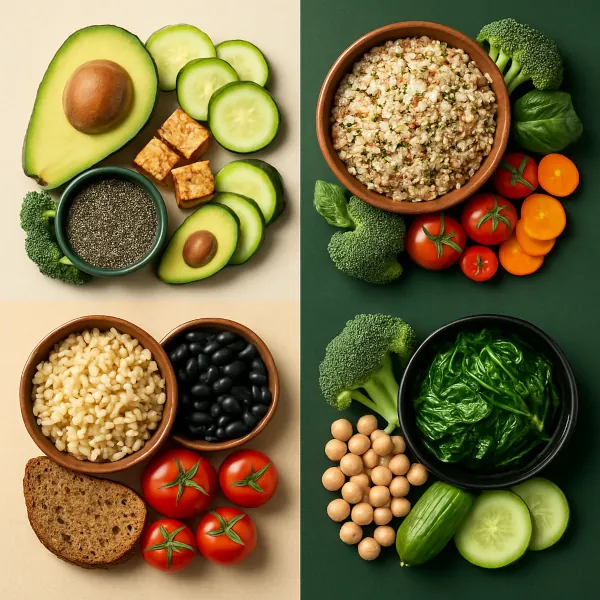Thinking about going vegan but unsure which path to follow? We compare the keto vegan diet with other popular vegan approaches — so you can find the one that best suits your goals, preferences and lifestyle.
What Is a Keto Vegan Diet Comparison and Why Should You Care?
A keto vegan diet comparison helps break down the core differences between various plant-based eating styles — and more importantly, shows how those differences impact your health, energy levels and day-to-day life.
From macronutrient balance to meal planning, understanding what each approach offers can help you choose a path that feels sustainable, enjoyable and aligned with your health goals.
🧠 Did you know? According to the British Dietetic Association, well-planned vegan diets can support healthy living in people of all ages and may help reduce the risk of heart disease, Type 2 diabetes, and certain cancers.
Key Differences: How Do These Diets Actually Work?
A Quick Look at the Macronutrient Split
Each diet style varies in how much carbohydrate, protein and fat it includes:
| Diet | Carbs | Protein | Fats |
|---|---|---|---|
| Keto Vegan | 5–10% | 20–25% | 70–80% |
| Traditional Vegan | 60–75% | 15–20% | 10–20% |
| Low-Carb Vegan | 20–30% | 20–25% | 40–50% |
| Whole-Food Plant-Based | 60–70% | 15–20% | 10–20% |
🥕 Curious fact: The average British vegan eats nearly 50% more fibre than the national average, thanks to legumes, whole grains and vegetables.
The keto vegan diet is focused on nutritional ketosis — encouraging the body to use fat for fuel instead of glucose. Since most plant foods are naturally high in carbs, reaching ketosis as a vegan takes careful planning.
A traditional vegan diet usually emphasises grains, pulses, fruits and vegetables, making it rich in fibre and nutrients — but also fairly high in carbs.
Whole-food plant-based diets remove highly processed products and instead focus on nutrient-dense whole foods. Even if these foods are high in carbs, they come packed with vitamins, minerals and phytochemicals.
A low-carb vegan diet strikes a balance — it reduces sugars and refined carbs but doesn’t cut them to keto levels.
Potential Health Benefits: What Does Each Diet Offer?
🥑 Keto Vegan
- Promotes fat loss and appetite control
- May help regulate blood sugar and support people with type 2 diabetes or PCOS
- Encourages steady energy levels and mental clarity
- Can lower triglycerides and increase HDL (good) cholesterol
📚 One study published in Frontiers in Nutrition found that low-carb, high-fat diets like keto may reduce inflammation and improve insulin sensitivity. Read the study
🥕 Whole-Food Plant-Based
- May lower blood pressure, improve cholesterol, and reduce risk of chronic illness
- Supports gut health and immunity
- Associated with longer life expectancy
🌱 A 2019 study in The Lancet suggested that diets rich in whole, plant-based foods could prevent up to 11 million premature deaths per year globally. Source
🌾 Traditional Vegan
- Easy to follow, especially for beginners
- Can be budget-friendly with pantry staples like pasta, beans and frozen veg
- Risk of over-relying on processed vegan substitutes and added oils
🥦 Low-Carb Vegan
- Offers improved blood sugar regulation and weight management
- More sustainable than full keto for many people
- Helps reduce bloating and energy crashes
🔬 According to Harvard Health Publishing, plant-forward low-carb diets can improve metabolic health and aid in weight loss. Source
Common Challenges and Nutritional Gaps
Regardless of the diet type, all vegans should keep an eye on some essential nutrients:
- Vitamin B12 – Not present in plant foods; supplementation is essential.
- Omega-3 fatty acids (EPA/DHA) – Flaxseed, chia and walnuts provide ALA, but algae supplements are more effective for EPA/DHA.
- Iron and zinc – Plant-based sources like legumes and pumpkin seeds are helpful, especially when combined with vitamin C for absorption.
🍋 Tip: Add a squeeze of lemon or orange juice to lentil dishes to enhance iron absorption.
Diet-Specific Concerns
| Diet | Main Drawbacks |
|---|---|
| Keto Vegan | Difficult to maintain, expensive ingredients, very restrictive |
| Whole-Food | Requires more prep, can be lower in calories unintentionally |
| Traditional | Easy to eat lots of refined carbs or processed food |
| Low-Carb | Limits fruit and legumes, needs careful meal planning |
🍄 Did you know? Mushrooms contain unique antioxidants and are one of the only plant foods with natural vitamin D when exposed to sunlight.
Sample Meal Plans by Diet Type
🥑 Keto Vegan
- Breakfast: Avocado smoothie with coconut milk, spinach, chia seeds, and hemp protein
- Lunch: Cauliflower rice bowl with grilled tofu, courgette, and tahini dressing
- Dinner: Stir-fried mushrooms with kale, olive oil and a side of almond “ricotta”
🥕 Whole-Food Plant-Based
- Breakfast: Porridge oats with banana, flaxseed, berries and oat milk
- Lunch: Mixed bean salad with quinoa, roasted vegetables and lemon-tahini dressing
- Dinner: Sweet potato curry with lentils and brown rice
🌾 Traditional Vegan
- Breakfast: Toast with peanut butter and herbal tea
- Lunch: Whole wheat pasta with tomato sauce and lentil “meatballs”
- Dinner: Vegan chilli with rice and avocado slices
🥦 Low-Carb Vegan
- Breakfast: Unsweetened soy yoghurt with almonds, raspberries and pumpkin seeds
- Lunch: Courgette noodles with tofu, olive oil, and fresh herbs
- Dinner: Aubergine and chickpea stir-fry with steamed broccoli
Pros and Cons of Each Diet at a Glance
| Diet | Advantages | Disadvantages |
|---|---|---|
| Keto Vegan | Fast weight loss, supports blood sugar balance | Difficult to maintain, low variety |
| Whole-Food Plant-Based | Excellent for heart health and long-term wellness | May require more cooking and preparation |
| Traditional Vegan | Easy to follow, affordable | May lead to nutrient gaps or overeat processed food |
| Low-Carb Vegan | Balanced, effective for weight control | Can be restrictive with fruit and grains |
Which Diet Suits You Best?
| Personal Goal or Lifestyle | Recommended Diet |
|---|---|
| Quick weight loss | Keto Vegan |
| Improved blood sugar control | Keto or Low-Carb Vegan |
| Busy or just starting out | Traditional Vegan |
| Focus on long-term health | Whole-Food Plant-Based |
| High physical activity | Plant-Based or Low-Carb |
| Cholesterol reduction | Whole-Food Plant-Based |
| Love to cook and experiment | Keto Vegan or Whole-Food |
🏃♂️ Tip for fitness lovers: Creatine supplements are popular among athletes — vegan versions are available and effective for performance and recovery.
Frequently Asked Questions
❓ Can I build muscle on a vegan keto diet?
Yes, with proper protein sources like tempeh, tofu, seitan and vegan protein powder.
❓ Is it safe to combine vegan and keto diets?
Yes — but it’s important to plan carefully, stay hydrated, and supplement key nutrients.
❓ Can I switch between diets over time?
Absolutely. Many people cycle between whole-food and low-carb approaches depending on goals.
How to Get Started Today
- Choose your preferred approach based on your health priorities.
- Plan a weekly menu with 2–3 repeatable meals.
- Get your supplements — B12, omega-3s and possibly iron.
- Shop smart — stock up on plant protein, veggies, healthy fats and spices.
- Start tracking your food using tools like Cronometer or Nutracheck.
- Keep it flexible — adapt meals as you go and don’t be too strict early on.
Make It Work in Real Life
- Prep ingredients in bulk at the weekend
- Keep healthy snacks on hand like roasted chickpeas, nuts, or hummus and crudités
- Celebrate variety — try global recipes and cuisines
- Stay consistent, not perfect — small daily habits make a big difference
📢 Final Thoughts
✨ Feeling inspired to try one of these vegan diets? Bookmark this guide, share it with a friend, and take the first step today!
💬 Which plant-based path are you most curious to explore? Let us know in the comments below!

